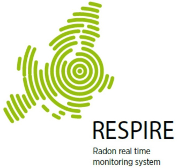About radon
Introduction
Radon (222Rn) is a colourless, odourless, invisible radioactive gas formed continuously in the Earth. It origins by the radioactive decay of trace quantities of Uranium (238U) naturally occurring in all rock and soils. Some rock types, such as granite and volcanic, contain more uranium than others and thus produce more radon.
How does radon forms?
The radioactive decay of uranium forms other elements, that are also unstable so the process is repeated until a stable element is formed. The energy release by the decay is called radiation (alpha and beta particles and gamma ray). Alpha particles are more harmful than beta particles or gamma rays because they have more energy and are absorbed over a smaller area.
Why is radon risk to our health?
Radon is the only gaseous element among the decay products of uranium gas. It is also unstable; it decays by emitting alpha particles and forms other elements that may attach to air particulate. In this form, it can be easily inhaled and enter our lungs. Here, the alpha particles emitted by its radioactive decay are absorbed by the lung tissues thus causing damage to cell DNA that can lead to lung cancer. Alpha particles cannot penetrate external skin formed by dead cells, but affect internal tissues because they are formed by living cells that cannot stop this type of radiation.
For these reason, radon has been classified by the International Agency for Research on Cancer (IARC) as a Group 1, a known cause of cancer in humans1,2. The U.S. Environmental Protection Agency estimates that radon causes about 21,000 lung cancer deaths in the United States each year. Though other researches provide different estimates of lung cancer evidence for humans and animals, however there is general agreement that radon exposure is the second leading cause of lung cancer among non-smokers (1 out 20). The risk increases up to 1 out 3 for smokers.
Pie chart Home related Deaths by Cause (data from Center for Desease Control and Prevention, 2017, https://www.cdc.gov/cancer/dcpc/prevention/policies_practices/radon/. Radon is thought to cause about 21,000 lung cancer deaths per year, according to EPA’s 2003 Assessment of Risks of Radon in Homes (EPA 402-R-03-003)[PDF-548KB]. The numbers of deaths from other causes are taken from the Centers for Disease Control and Prevention’s 1999–2001 National Center for Injury Prevention and Control Report and 2002 National Safety Council Report.)
How and where can we expose to radon?
The outdoor air contains very low radon concentrations (about 10 Bequerel per cubic meter, Bq/m3), therefore the exposure to radon mostly occurs through the air inside buildings (indoor radon). Radon, formed from the natural decay of uranium or thorium in nearly soils, moves up through the ground and enter homes or workplaces through wall and slab joints, cracks and openings in foundations, windows, water pipes and water tanks. It can also be released from building materials or from well water. Generally, basements and cellars have some of the highest radon levels because they are situated close to the source of radon and tend to have low ventilation. However, some buildings may have higher radon concentrations in the upper floors due to the building material, or artificial ventilation.
Radon Legislation
The recent Council Directive 2013/59/Euratom of 5 December 2013 (Laying down basic safety standards for protection against the dangers arising from exposure to ionising radiation, and repealing Directives 89/618/Euratom, 90/641/Euratom, 96/29/Euratom, 97/43/Euratom and 2003/122/Euratom) (https://ec.europa.eu/energy/sites/ener/files/documents/CELEX-32013L0059-...) that should be adopted by member states in February 2018) establishes that Member States shall promote actions to identify dwellings with radon concentrations (as an annual average) exceeding the reference level and encourage radon reducing measures (Art.74-2 and Art. 103-1,2,3).
Point 22 of the preamble of the Directive mentions that “Recent epidemiological findings from residential studies demonstrate a statistically significant increase of lung cancer risk from prolonged exposure to indoor radon at levels of the order of 100 Bq/m3”. To avoid negative effects on human health it is important to ensure that the concentration of radon in working places and private homes shall not be higher than 300 Bq/m3 level (Art. 54-1 and Art. 71-1), but it is however advisable to keep the concentrations below 100 Bq/m3. Point 24 of the preamble mentions that “Where, due to national prevailing circumstances, a Member State establishes a reference level for indoor radon concentrations in workplaces that is higher than 300 Bq/m3, the Member State should submit the information to the Commission”.
References: USEPA: United States Environmental Protection Agency; WHO: World Health Organization; EU: European Union; N/A: not available; EU: European Union; ICRP: International Commission on Radiological Protection.
How can we reduce radon levels in workplaces and homes?
It is of course also advisable to check indoor air of public buildings and private homes, to protect the inhabitants from radon exposure. The most important remediation action consists in the ventilation of the buildings. Opening doors and windows will allow fresh air to enter and reduce radon gas in the home. However, natural ventilation is only a temporary fixing method and should be used only until further mitigation system will be applied. Mostly, radon mitigation systems work with pressurized fans or suction devices to create a vacuum in spaces that trap radon gas.
The RESPIRE project aims to provide integrated tools for automatic and continuous radon monitoring and mitigation methodologies for all stakeholders to address the need to reduce exposure to radon. RESPIRE remediation system prototypes consisting of the SNAP, Rn sensors and the subslab depressurization system for ventilation based on positive pressure, currently not feasible all over Europe especially during winter. RESPIRE innovative system is able to recover ~80% of heat from the air expelled from the house and transfer this heat to the air blown in, in a complete passive way.






